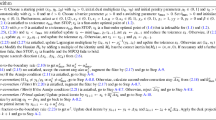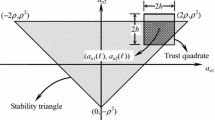Abstract
Computer-aided design optimization of electronic components is a powerful tool to reduce development costs on one hand and to improve the performance of the components on the other. In this paper, a mathematical model of an electronic filter is outlined. It depends on certain parameters, some of them of being continuous, others of integer type. The purpose of the paper is to introduce an extension of the well-known sequential quadratic programming (SQP) method to solve the mixed-integer programming problem (MINLP). It is assumed that the integer variables cannot be relaxed to real ones, that the integer range is sufficiently large, and that they possess some physical meaning so that they basically behave like continuous ones. The general idea is to combine an SQP step with a direct search cycle in the integer space. Hessian information is updated based on difference formulae at neighbored grid points. Numerical results are included to show the feasibility of the mixed-integer nonlinear programming code for academic test examples and in addition for the optimal design of an electronic filter.
Similar content being viewed by others
References
C. Audet and J. E. Dennis, “Pattern search algorithms for mixed variable programming,” SIAM Journal on Optimizationvol. 11, pp. 573–594, 2001.
E. M. L. Beale, “Integer programming,” in The State of the Art in Numerical Analysis, D.A.H. Jacobs (Ed.), Academic Press: London, 1978.
J. Z. Cha and R. W. Mayne, “Optimization with discrete variables via recursive quadratic programming: Part 1-concepts and definitions,” Journal of Mechanisms, Transmissions, and Automation in Design vol. 111, pp. 124–129, 1989a.
J. Z. Cha and R. W. Mayne, “Optimization with discrete variables via recursive quadratic programming: Part 2-algorithm and results,” Journal of Mechanisms, Transmissions, and Automation in Design vol. 111, pp. 130–136, 1989b.
R. J. Dakin, “A tree search algorithm for mixed integer programming problems,” Computer HJournalvol. 8, pp. 250–255, 1965.
M. Duran and I. E. Grossmann, “An outer-approximation algorithm for a class of mixed-integer nonlinear programs,” Mathematical Programming vol. 36, pp. 307–339, 1986.
T. F. Edgar and D. M. Himmelblau, Optimization of Chemical Processes, McGraw Hill, 1988.
A. Fischer, “A special Newton-type optimization method,” Optimization vol. 24, pp. 269–284, 1992.
C. A. Floudas, Nonlinear and Mixed-Integer Optimization, Fundamentals and Applications,” Oxford University Press: New York, 1995.
P. E. Gill, W. Murray, and M. H. Wright, Practical Optimization, Academic Press, 1981
D. Goldfarb and A. Idnani, “A numerically stable method for solving strictly convex quadratic programs,” Mathematical Programming vol. 27, pp. 1–33, 1983.
I. E. Grossmann and Z. Kravanja, “Mixed-integer nonlinear programming: A survey of algorithms and applications,” in Biegler, Coleman, Conn, and Santosa (Eds.): The IMA Volumes in Mathematics and its Applications, vol. 93, Large-Scale Optimization with Applications. Part II: Optimal Design and Control, Springer, Berlin, 1997, pp. 73–100.
O. K. Gupta and A. Ravindran, “Nonlinear integer optimization and discrete optimization,” Transactions of the ASME vol. 105, pp. 160–164, 1983.
S.-P. Han, “A globally convergent method for nonlinear programming,” Journal of Optimization Theory and Applications vol. 22, pp. 297–309, 1977.
C. Hartwanger, K. Schittkowski, and H. Wolf, “Computer aided optimal design of horn radiators for satellite communication,” Engineering Optimization vol. 33, pp. 221–244, 2000.
W. Hock and K. Schittkowski, “A comparative performance evaluation of 27 nonlinear programming codes,” Computing vol. 30, pp. 335–358, 1983.
P. D. Hough, T. G. Kolda, and V. J. Torczon, “Asynchronous parallel pattern search for nonlinear optimization,” SIAM Journal on Scientific Computing vol. 23, pp. 134–156, 2001.
C. T. Kelley, Iterative Methods for Optimization, SIAM: Philadelphia, 1999.
W. Kleber, “Einführung in die Kristallographie,” VEB Verlag Technik: Berlin, 1985.
G. R. Kocis and I. E. Grossmann, “Global optimization of nonconvex mixed-integer nonlinear programming (MINLP) problems in process synthesis,” Industrial and Engineering Chemical Research vol. 27, pp. 1407–1421, 1988.
R. M. Lewis, V. Torczon, and M. W. Trosset, “Direct search methods: then and now,” Journal of Computational and Applied Mathematics vol. 124, pp. 191–207, 2000.
S. Leyffer, “Deterministic methods for mixed integer nonlinear programming,” PhD Thesis, Department of Mathematics and Conputer Science, University of Dundee, 1993.
S. Leyffer, “Integrating SQP and branch-and-bound for mixed integer nonlinear programming,” Computational Optimization and Applications vol. 18, pp. 295–309, 2001.
H. Li and C. Chou, “A global approach for nonlinear mixed discrete programming in design optimization,” Engineering Optimization vol. 22, pp. 109–122, 1994.
H. T. Loh and P. Papalambros, “A sequential linearization approach for solving mixed-discrete nonlinear design optimization problems,” Journal of Mechanical Design vol. 113, pp. 325–334, 1991.
K. Miettinen, M. M. Mäkelä, P. Neittaanmäki, and J. Periaux, Evolutionary Algorithms in Engineering and Computer Schience, John Wiley: Chichester, 1999.
G. R. Olsen and G. N. Vanderplaats, “Method for nonlinear optimization with discrete design variables,” AIAA Journal vol. 27, pp. 1584–1589, 1989.
P. Y. Papalambros and D. J. Wilde, Principles of Optimal Design, Cambridge University Press, 2000.
M. J. D. Powell, “A fast algorithm for nonlinearly constraint optimization calculations,” in Numerical Analysis,G. A. Watson (Ed.), Lecture Notes in Mathematics, vol. 630, Springer, 1978a.
M. J. D. Powell, “The convergence of variable metric methods for nonlinearly constrained optimization calculations,” in Nonlinear Programming 3, O. L. Mangasarian, R. R. Meyer, and S. M. Robinson (Eds.), Academic Press, 1978b.
M. J. D. Powell, “On the quadratic programming algorithm of Goldfarb and Idnani,” Report DAMTP 1983/Na 19, University of Cambridge: Cambridge, 1983.
K. Schittkowski, Nonlinear Programming Codes, Lecture Notes in Economics and Mathematical Systems, vol. 183, Springer, 1980.
K. Schittkowski, “Theory, implementation and test of a nonlinear programming algorithm,” in Optimization Methods in Structural Design, H. Eschenauer and N. Olhoff (Eds.), Wissenschaftsverlag, 1983.
K. Schittkowski, “On the convergence of a sequential quadratic programming method with an augmented Lagrangian search direction,” Optimization vol. 14, pp. 197–216, 1983.
K. Schittkowski, “NLPQL: A Fortran subroutine solving constrained nonlinear programming problems,” Annals of Operations Research vol. 5, pp. 485–500, 1985/86.
H.-P. Schwefel, Evolution and Optimum Seeking, John Wiley: New York, 1994.
P. Spellucci, Numerische Verfahren der nichtlinearen Optimierung, Birkhäuser, 1993.
J. Stoer, “Foundations of recursive quadratic programming methods for solving nonlinear programs,” in Computational Mathematical Programming, K. Schittkowski (Ed.), NATO ASI Series, Series F: Computer and Systems Sciences, vol. 15, Springer, 1985.
G. Tobolka “Mixed matrix representation of SAWtransducers,” Proceedings of the IEEE Ultrasonics Symposium vol. 26, pp. 426–428, 1979.
V. Torczon, “On the convergence of pattern search algorithms,” SIAM Journal on Optimization vol. 7, pp. 1–25, 1997.
G. van de Braak, Das Verfahren SQMIP zur gemischt ganzzahligen nichtlinearen Programmierung für den Entwurf elektronischer Bauteile, Diploma Thesis, Department of Mathematics, University of Münster, Germany, 2001.
S. Wang, K. L. Teo, and H. W. J. Lee, “A new approach to nonlinear mixed discrete programming problems,” Engineering Optimization vol. 30, pp. 249–262, 1998.
Author information
Authors and Affiliations
Rights and permissions
About this article
Cite this article
van de Braak, G., Bünner, M.J. & Schittkowski, K. Optimal Design of Electronic Components by Mixed-Integer Nonlinear Programming. Optimization and Engineering 5, 271–294 (2004). https://doi.org/10.1023/B:OPTE.0000038887.72677.3e
Issue Date:
DOI: https://doi.org/10.1023/B:OPTE.0000038887.72677.3e




